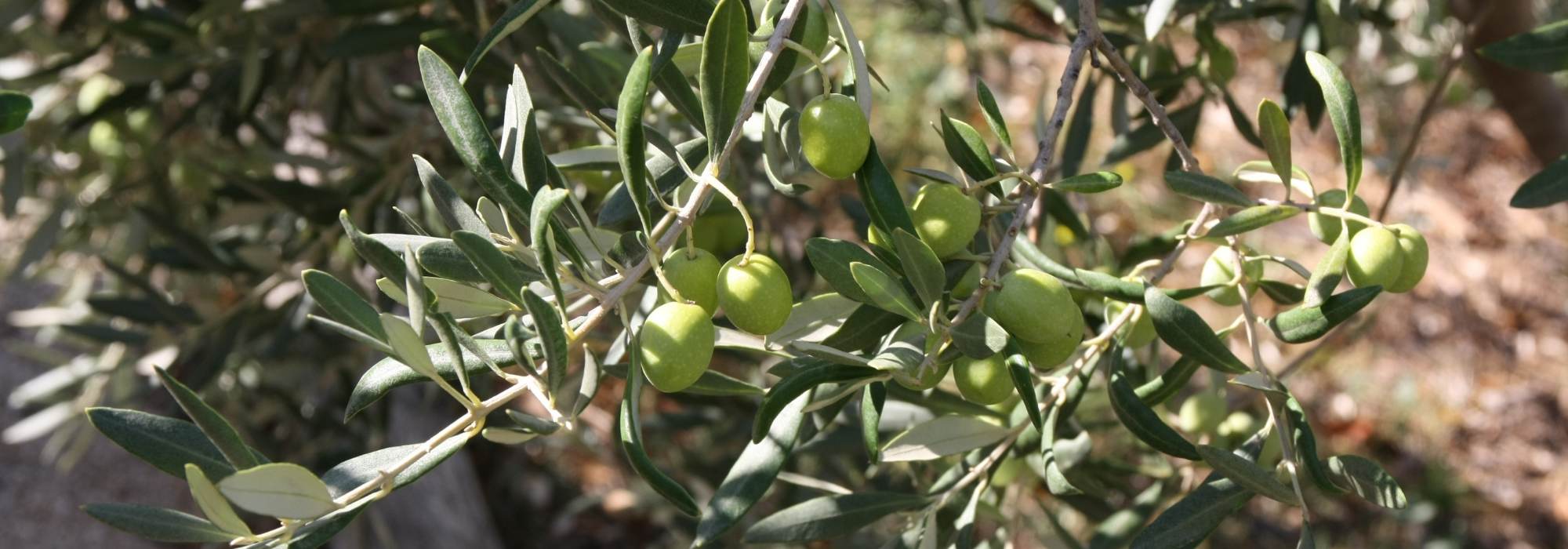
Olive tree, Olea europaea: planting, pruning
Summary
Olive tree in a nutshell
- Olive tree is typical of Mediterranean gardens
- With exceptional longevity, it can live for several centuries
- With its nodose trunk and silvery evergreen foliage, it evokes warmth and sunshine
- It grows in full sun and only in well-drained soil
- Hardy down to -10°C, but best planted in ground only in mild climates
A word from our expert
With its trunk sculpted by age and its evergreen, silvery leaves, the Olea europea or common olive is the emblematic tree of Mediterranean landscapes and symbol of peace.
Nicknamed « l’arbre de vie », the olive has a slow growth but exceptional longevity, being capable of living for several thousand years.
Whether a fruit tree, cultivated since time immemorial for its green or black fruits and for its oil, or an ornamental olive, this legendary tree, laden with meaning, instantly evokes Provence and sunbaked land!
Very fashionable in recent years in minimalist settings, the olive brings an elegant, exotic touch to gardens in our mildest regions.
Rather tender, elsewhere it will be grown like conservatory plants, in a large pot moved indoors for winter into a conservatory or greenhouse. But what a joy to bring it back out at first rays of sunshine!
Once well established in a sunny spot, in drained soil, the olive requires little maintenance.
From planting to pruning of the olive, here are all the secrets to to grow this noble, robust and immortal tree. Discover our lovely collection of olive trees: guaranteed to transport you!
They instantly evoke the Mediterranean: be tempted by our Mediterranean fruit trees!
Description and botany
Botanical data sheet
- Latin name Olea europæa
- Family Oleaceae
- Common names Olive
- Flowering April to July
- Height 2 to 20 m
- Sun exposure sun
- Soil type all, well-drained
- Hardiness -10 to -15°C
Emblem of Mediterranean landscapes, Olea europaea or common olive belongs to family Oleaceae like lilacs. Cultivated since time immemorial for its green or black fruits and for its oil, it occurs naturally in dry, rocky soils around Mediterranean basin, from Africa to central Asia, even in Australia. Genus includes about thirty species, among which Olea europæa is most widespread. Nearly 2,000 olive varieties are recorded; ‘Olivier Lucques’, ‘Aglandau’, ‘Bouteillan’, ‘Cailletier’ or ‘olive de Nice’, ‘Picholine’, most common in France, are among best-known cultivars.
Olive’s slow growth matches its exceptional longevity that can exceed 3,000 years! It shows a picturesque habit, upright with a rounded crown, spreading and becoming more pronounced with age. Olive takes on a characteristic distorted aspect with age, its bark grey and fissuring over time. It may assume varied silhouettes, with a single trunk or multiple trunks, branches erect or nearly pendulous depending on variety. Tree produces suckers, called “souquets”, at trunk base.
While it can reach 15 to 20 m in wild state, it generally does not exceed 2 to 10 m in height in cultivation.
Evergreen and leathery foliage covers branches clothed in peltate scales. Foliage renews constantly, leaves living about three years. Leaves are opposite, entire or irregularly dentate, ovate to elliptical, elongated with prominent midveins. Measuring 3 to 9 cm, they are glossy dark green or grey-green above, with a silvery, downy underside.
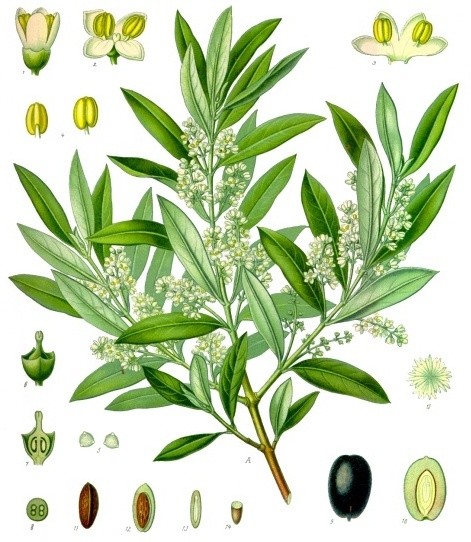
Olea europaea – botanical illustration
In spring, from April to June depending on climate, this bushy, bluish crown trembling in wind is covered with a discreet and fugacious white flowering. Countless small white or cream flowers 2 to 5 mm long, gathered in small clusters in leaf axils, open on previous year’s wood, adding to its charm. Tubular corolla formed of four rounded petals reveals yellow stamens laden with pollen that can be allergenic.
Although this flowering lasts only about a week, it is very nectariferous, attracting numerous pollinating insects such as bees.
Fruit set in olive occurs only in warm regions and only after 7 to 10 years of growing, although some varieties crop sooner. Tree can then fruit until around 150 years of age. Most olive trees are self-fertile, while others will require presence of another olive tree pollinator to fruit.
In summer, flowers then transform into fleshy drupes with a hard stone, 2 to 4 cm long — olives, first a lovely pale green, then purple and finally black at full ripeness. They are sometimes covered with a thick bloom, and taste so bitter that they are inedible raw. These lipid-rich fruits vary by variety: elongated, crescent-shaped and very smooth in ‘Lucques’, spherical or ovoid in others.
Depending on region, olive harvest takes place in autumn or winter. It takes about 4 to 6 kg of olives to obtain one litre of oil and to prepare them to remove all bitterness. Preparation methods are so laborious that it is far preferable to grow olive in garden only for its iconic Mediterranean beauty.
Common olive is planted across France but grown differently from region to region. From its Mediterranean origins it retains some chill-sensitivity preventing survival below about -10 to -12°C, sometimes down to -15°C in well-drained soil. Outdoor cultivation should therefore be reserved to the area called “olive zone”, in regions with mild winters and dry summers! North of Loire, it will acclimatise without problem in a large pot to be protected from severe cold during winter.
Olive requires a sunny position, sheltered from cold winds, and deep, well-drained soil, even stony or calcareous; it dislikes only waterlogged soils.
With its twisted silhouette, common olive is a very ornamental tree that benefits from being planted in isolation. Essential in Mediterranean-inspired dry gardens, it can also be placed at centre of a border, as an avenue tree, or as a windbreak. In cold regions, in a large container, it brings an exotic note to terraces and balconies.
Its wood is so hard that it is highly prized in cabinetmaking, sculpture and for making kitchen utensils. Its oil ranks among best table oils and is also much valued in cosmetics. Olive leaves have medicinal properties — digestive, diuretic and antihypertensive.
Presence of olive dates back to time immemorial; this legendary tree is a symbol of peace. In ancient Greece, victors at the games were also crowned with olive branches representing strength and victory.
You may also read
Mediterranean garden: 10 iconic plants to landscape itMain species and varieties
The genus comprises around thirty species of olive, the most widespread being Olea europaea. It includes many varieties. Those we offer are easy to grow, attractive and robust, within reach of all amateur gardeners.
Most popular
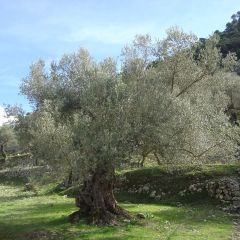
Olea europaea Stem - Olive
- Flowering time july
- Height at maturity 9 m
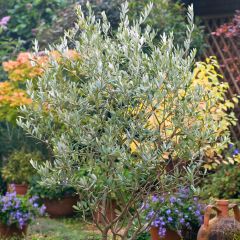
Olive Tree - Olea europaea
- Flowering time july
- Height at maturity 9 m

Olea europaea Stem - Olive
- Flowering time july
- Height at maturity 9 m
Discover other Olive trees
View All →Available in 1 sizes
Available in 6 sizes
Available in 1 sizes
Available in 2 sizes
Available in 1 sizes
Available in 1 sizes
Available in 1 sizes
Available in 1 sizes
Available in 1 sizes
Available in 1 sizes
Planting an olive tree
Where to plant an olive tree?
Olea europea or common olive is planted throughout France, but is grown differently depending on region. It is a relatively frost-sensitive tree, nevertheless capable of withstanding short frosts of around -10°C to -12°C, in well-drained soil.
It is easy to grow in regions with mild winters. In open ground, reserve it for Mediterranean climates, with hot, dry summers because it does not tolerate excess water. Elsewhere, grow it in a large pot, an orangery tub for example, and move it under cover to protect from frost in the cold season.
It requires a sunny spot sheltered from prevailing cold winds and draughts, particularly in less favourable regions.
Particularly suited to Mediterranean climate, it is very drought-resistant and undemanding regarding soil type: it will settle for ordinary, deep soil and is capable of prospering in poor, stony ground provided it is permeable and well drained. It dislikes heavy, waterlogged soils where water stands: it will naturally find its place on a large arid bank.
Easy to grow in a pot as well as in open ground, it gives gardens and terraces a Mediterranean feel. It can be placed in centre of a summer border, as an avenue tree or even in a windbreak hedge.
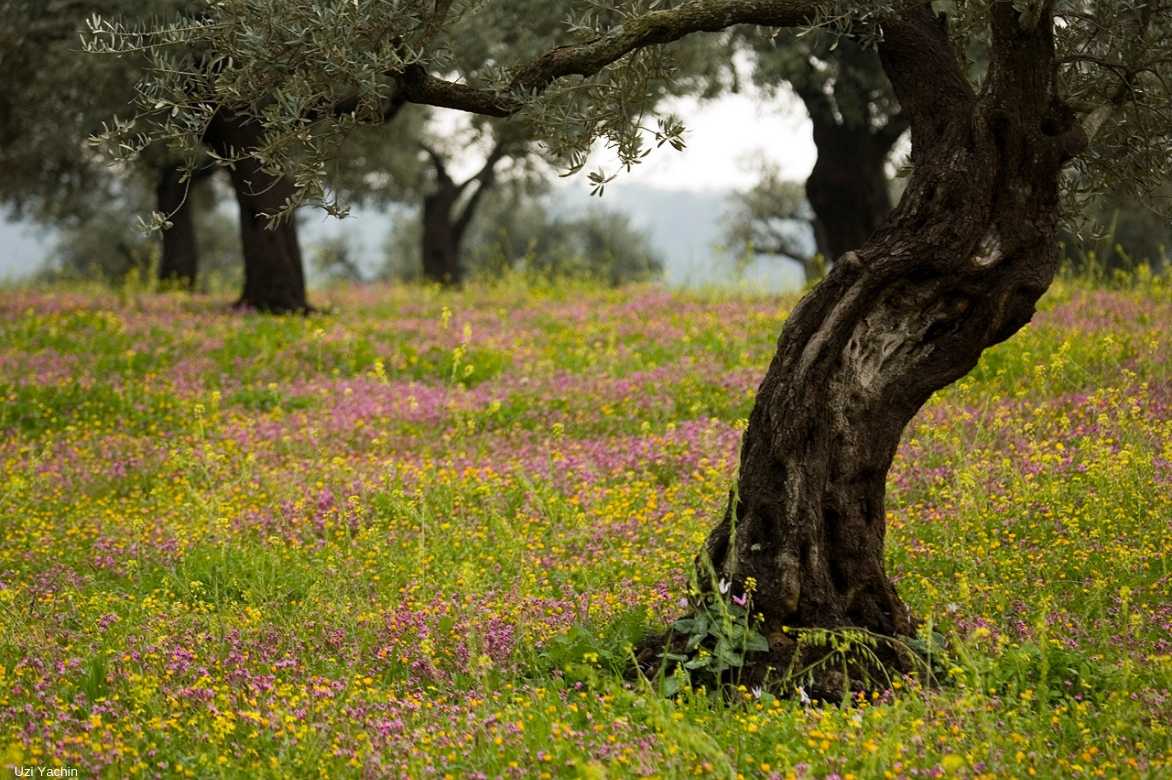
When to plant an olive tree?
Olive is best planted in late spring, once risk of frost has passed because young olive trees are particularly vulnerable to cold. Our container-grown plants can be planted all year round in regions with a very mild climate.
How to plant an olive tree?
Olive prefers well-drained ground. In open ground or in a pot, follow Ingrid’s advice to plant an olive correctly.
In open ground
Space olive trees 6 to 8 m apart in all directions. If your soil retains moisture, do not hesitate to plant it on top of a mound, where water will not stand.
- Loosen soil well and dig a hole three times wider than the rootball
- Add a good layer of pozzolana, river sand or gravel to the bottom of the planting hole
- Use a stake to protect it from strong winds
- Backfill with potting compost and sand mixed with the excavated soil
- Keep the olive upright then fill in the hole
- Firm down with your foot then form a basin around the base
- Water well at planting then regularly in dry weather during first year after planting
In a pot
Substrate must be very free-draining to avoid rot relating to root and stagnant moisture at the base of the Olive.
- In the bottom of a container at least 2 to 3 times larger than the volume of the rootball, spread a good layer of drainage material
- Plant in an equal-parts mix of potting compost and garden soil with a little sand added
- Use a stake suited to the size of your olive tree
- Water well at planting
- Move the pot under cover to protect from frost in autumn in cold regions
⇒ To find out more: Growing an olive in a pot
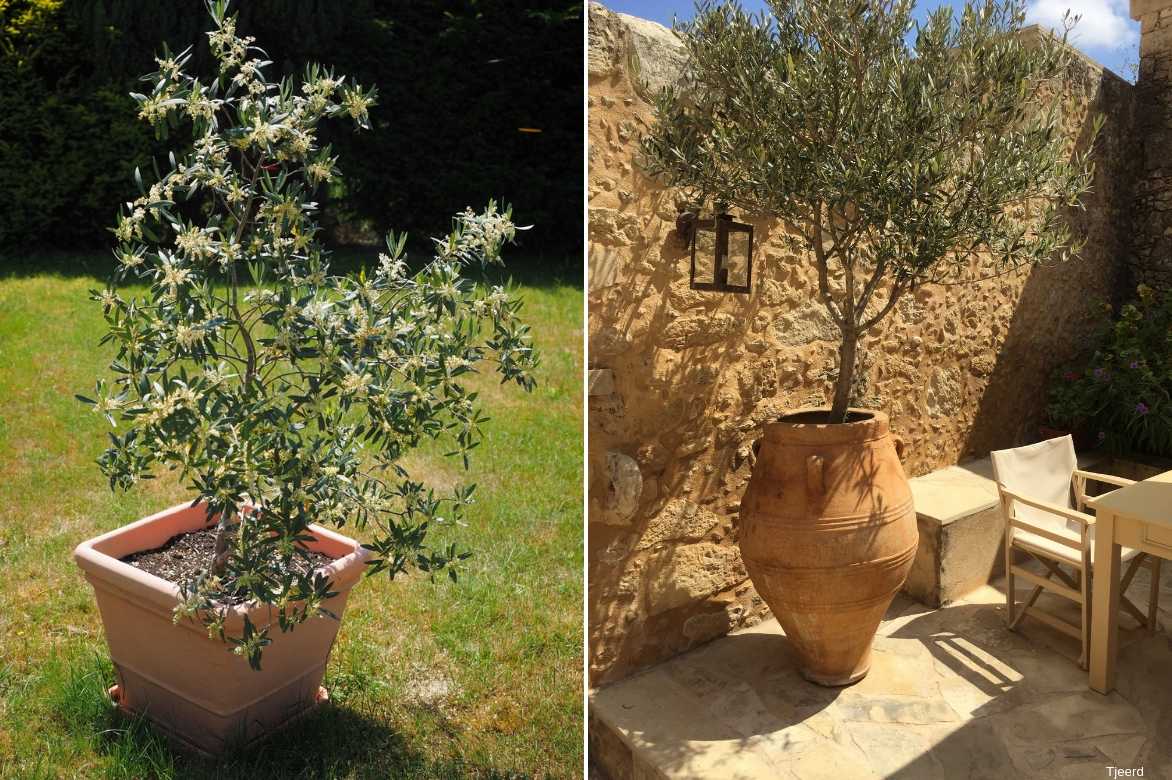
Growing an olive tree in a pot is entirely possible… makes a striking feature on a terrace!
You may also read
Provence Hackberry: planting, cultivation, maintenanceWhen and how to sow olive seeds?
Les olive tree seeds are sown from March to June, be patient, germination is slow and somewhat erratic!
- Scarify seeds with a knife: nick the surface of seeds with a sharp knife, or scratch them with sandpaper to ease germination and water penetration
- Plant seeds in individual buckets
- Keep substrate moist, but not waterlogged during germination which takes several months
- Keep sowings warm at 20-25°C
- Pot on into larger pots following spring; wait one year before planting your young olive plants outdoors
Maintenance, pruning and care of olive trees
In open ground
Olive trees are easy to grow in favoured regions where frost is neither severe nor prolonged. They need regular watering during their first two years to establish well.
Once well established, they become increasingly drought-resistant. In summer, water once or twice a month, taking care not to waterlog the soil.
Add a little well‑rotted compost around the tree base in spring and autumn to encourage growth.
The top of young olive trees planted in open ground can be protected with a winter fleece during the first years before cold weather arrives to help them through the winter.
In pots
Water potted olive trees in pots very regularly, allowing the soil to dry between waterings and without letting water stand in the saucer.
In autumn or spring, repot every 2 or 3 years into a slightly larger container or simply replace surface soil with fresh potting compost.
Frost can kill it below about -10°C: in cold regions, store the pot from October to March in an unheated or lightly heated greenhouse or conservatory where temperature does not fall below 10°C, and return it outdoors as soon as temperatures rise.
Pruning of the olive tree
Pruning an olive tree is carried out in spring, from March to mid‑May. Pruning an olive grown for ornamental purposes is not demanding: it is light and helps maintain an attractive habit and strengthen the trunk.
Each year, carry out a spring clean‑up and a thinning prune by removing dead and tangled branches to open up the centre of the branches:
- Clear the trunk by removing the least vigorous branches
- Remove any suckers at the base of the trunk
- In the south, to encourage olive production, prune every 2 or 3 years because fruits appear on the previous year’s wood
⇒ Also read: Pruning the olive tree: regularity, methods and advice… Everything you need to know!
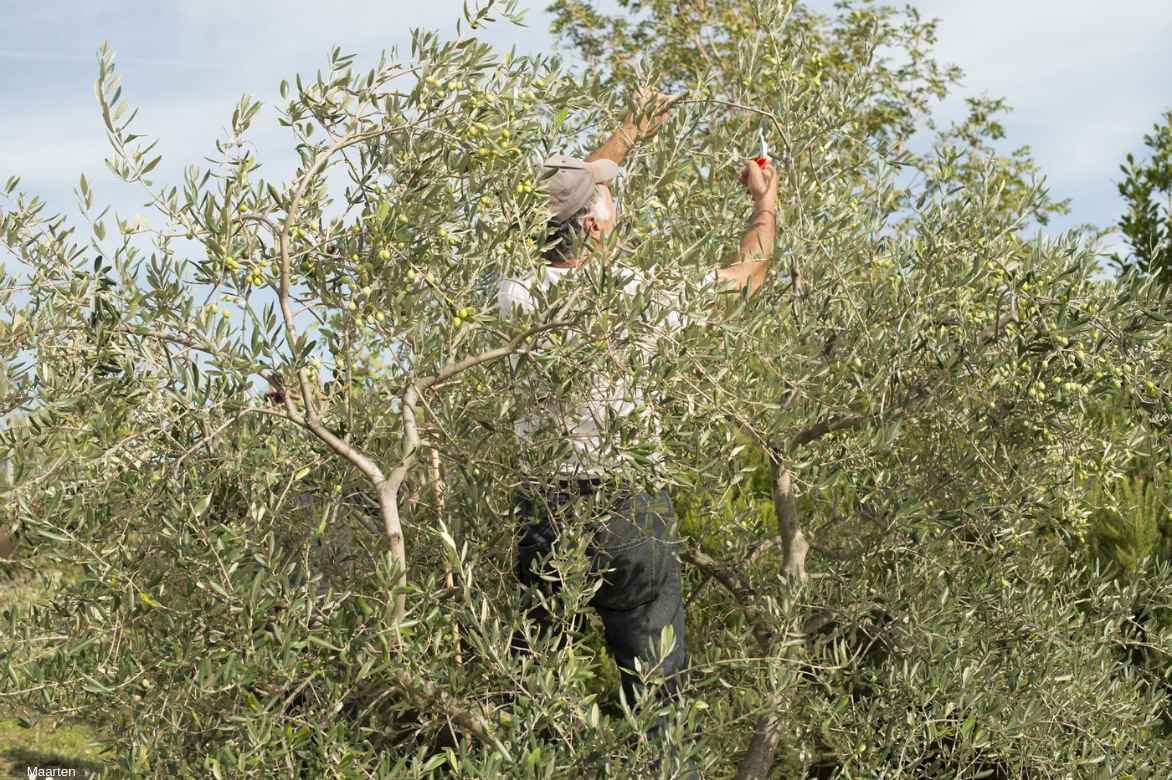
Pruning the olive tree
Possible diseases and pests
Olive tree is a resilient tree that can survive for centuries! However, although hardy, olive tree has a few well-known pests that are rarely fatal, mainly troublesome for fruit production. An infested olive tree is easy to treat.
Among its notorious enemies, the olive fruit fly is the most feared because it makes fruit unsuitable for consumption: a few pheromone traps and sprays of a clay-based solution can be enough. Olive thrips are small sucking flies that deform leaves and fruit but usually do not require treatment, black scale causes sooty mould on leaves; prevent with sprays of oil and black soap or, more simply, Bordeaux mixture in early spring.
Bark beetle and olive moth are more troublesome because they attack young shoots and flower buds: cut and burn affected branches as soon as they appear dry or diseased. Olive pyralid, a small moth, causes little damage.
If edges of young leaves are eaten in an arc, otiorhynchus weevil is devouring them!
On the disease side, olive tree is especially vulnerable to fungal diseases linked to excess moisture in the soil and poor drainage. Most are not serious.
Root rot and verticillium wilt are the rare true deadly diseases for olive tree: the first attacks the roots causing gradual decay of the entire tree, the second causes sudden drying out of one or more branches. The only real prevention is to plant olive tree in light, free-draining soil that does not retain water because there is no effective treatment.
Peacock eye (Cyclonium oleaginum) is also a frequent disease that causes circular yellow or brown spots on olive leaves, weakening the tree; it particularly affects potted olive trees. Affected leaves eventually turn completely yellow and fall: as a preventive measure, apply sprays of Bordeaux mixture.
The canker of olive appears as warty growths or “cankers” on the wood; it is common on fruit trees and is mainly unsightly: cut and burn affected branches.
In general, to avoid most of these diseases: spare olive tree heavy, wet soils, avoid overwatering and avoid watering leaves directly.
Rabbits love olive bark: protect young trunks with wire mesh.
Finally, in recent years olive trees in Corsica and Italy have been affected by the killer olive bacterium: Xylella fastidiosa, responsible for the Olive Quick Decline Syndrome (CoDiRO). Against this “olive plague” there is currently no treatment.
→ Find out about diseases and parasites of olive tree and about the canker of olive: identification and treatment in our advice sheets!
→ Discover our advice on getting rid of psyllids
Propagation
Although olive tree can be propagated by olive tree by sowing (see above), by semi-ripe cuttings, layering or grafting (see our tutorial How to propagate olive tree?), we recommend instead the propagation by suckers, which is much quicker and less tedious provided garden has an old stump already well established.
By suckers
- In spring, use a mattock to detach from base of trunk a well-rooted sucker
- Replant immediately in garden in well-prepared, free-draining soil
- Prune severely to encourage regrowth
Pairing olive trees with your garden
Staple tree of sun‑baked Mediterranean gardens, Olive is also an asset in a mineral garden, surrounded by rockery plants.
It is perfect alongside Mediterranean perennial plants undemanding such as Santolina, rosemary, Artemisia, sedums, lamb’s ears or even Spanish grass, creating a lovely harmony of silvery foliage.

One planting idea in mild climate: Olea europaea, Phormium ‘Pink Stripe’, Santolina ‘Edward Bowles’, Rosmarinus officinalis, Pittosporum tenuifolium ‘Golden Ball’, Geranium renardii and Euphorbia characias ‘Purple and Gold’
In mineral scenes, pair its gnarled silhouette with plants that enjoy same growing conditions such as agaves, blue oat grass, blue fescue, Eryngium.
Its grey‑green foliage reveals itself in fresh, very soft palettes. In that spirit, for a chic, classic look, lavender planted in a line at its feet is magnificent, as are shrub roses with pink or white flowers. In a flowering hedge, it sits easily alongside some summer‑flowering bushes such as Cistus and Lavatere, white and pink almond trees, creating delicate, romantic compositions.
It also stands out with oleanders, holm oaks, cypresses and myrtles.
The blue‑tinged colour of its leaves pairs easily with complementary tones such as yellow of Helenium, Echinacea, euphorbias and with glaucous or grey tones of foliage from an Artemisia or a Helichrysum italicum.
While it looks good planted singly on large sunny banks, it can be centrepiece of a large bed surrounded by perennial plants with summer flowering such as daylilies, agapanthus, dianthus plumarius, irises and dry‑soil perennials such as Gaura, Nepeta, love‑in‑a‑mist, Erigeron karvinskianus, Epilobium or Salvia.
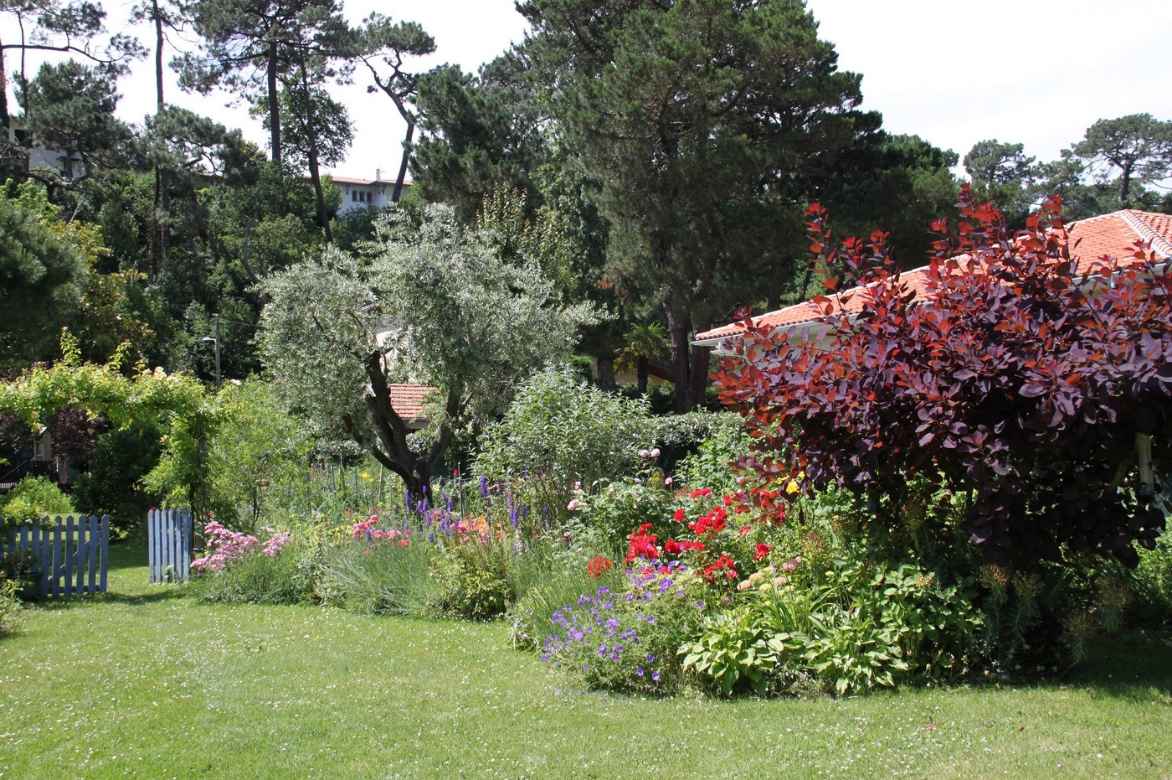
Garden scene with an olive, a smoke bush (‘Grace’, ‘Royal Purple’…), roses, hardy geraniums, sedums, achilleas, larkspur…
Further north, it is grown in large tubs alongside aubrieta, Osteospermum and dianthus.
Useful resources
- Pruning bushes without stress
- How to plant an olive tree?
- How to harvest and preserve olives?
- All our advice to grow fruit trees
- Discover Elisabeth’s Mediterranean garden!
- Learn more about Mediterranean trees in our advice sheet
- How to choose an olive tree?
- Olive leaf tea: benefits and recommendations
Frequent questions
-
Yellowing of olive tree leaves can come from several causes. To diagnose, check pattern of yellowing, soil and pot conditions, recent weather and care. Common causes and what to do: Main causes - Overwatering / poor drainage: Lower leaves yellow first, tree may wilt and soil stays wet. Roots can rot (Phytophthora). Remedy: reduce watering, improve drainage, repot into free‑draining mix if potted, avoid waterlogging. - Underwatering: Leaves yellow then brown and crispy at margins; branches may drop. Remedy: water deeply and regularly during dry spells, allow surface to dry slightly between waterings. - Nutrient deficiencies: - Nitrogen deficiency: uniform yellowing starting on older leaves and slow growth. Remedy: apply balanced fertiliser with nitrogen in spring. - Iron chlorosis: interveinal yellowing on young leaves (veins remain green), common on alkaline/calcareous soils. Remedy: apply chelated iron (Fe‑EDDHA) as soil or foliar treatment; consider long‑term soil acidification if needed. - Magnesium or other micronutrient deficiencies: typically affect older leaves first; correct with appropriate fertiliser or foliar feed after diagnosis. - Pests: Scale insects, aphids, mites can cause yellowing and sticky honeydew/sooty mould. Remedy: inspect underside of leaves and stems; treat with horticultural oil, insecticidal soap or targeted insecticide. - Diseases: Verticillium wilt causes branch‑by‑branch yellowing, wilting and dieback (often asymmetric). No reliable cure; remove badly affected branches and consult local specialist. Root rots from waterlogging can be fatal. - Cold or frost damage: Sudden yellowing and drop after frost events, especially on young trees or tender varieties. - Salt or fertiliser burn: Excessive fertiliser or saline water causes yellow/brown margins and leaf drop. Quick diagnosis checklist - Which leaves affected? New or old? Pattern uniform or interveinal? - Soil moisture: wet, damp or dry? Any bad smell from roots? - Pot or ground planting? Pot size and drainage? - Recent fertiliser, salt exposure or frost? - Visible pests or sticky residue on leaves? Practical immediate actions - Stop routine irrigation; check soil moisture with finger or meter. - Improve drainage (lift pot, add grit/perlite, create drainage channels). - Remove severely affected leaves/branches for assessment. - Treat obvious pests (horticultural oil for scale). - For suspected iron chlorosis, apply chelated iron for quick improvement. - For suspected root rot or Verticillium, consult local extension service or nursery for diagnosis and treatment options. Prevention - Plant in full sun and well‑draining soil. - Water moderately; avoid prolonged waterlogging. - Use slow‑release fertiliser in spring tailored to Mediterranean trees. - Monitor regularly for pests and stress after extreme weather. If you want, send a photo showing affected leaves and tell me whether tree is in pot or ground, recent watering and soil type — I can help narrow down likely cause and suggest specific treatment.
Olive tree has evergreen leaves renewed after about three years, so it is natural for the tree to permanently bear some scattered yellowed or damaged leaves. However, a large number of yellow leaves on the same branch can be a sign of a disease such as verticillium wilt or peacock eye. Monitor and remember that, above all, olive trees dread soil that is too compact and saturated with water, conditions often responsible for the appearance of disease.
-
Short answer: not necessarily — brown, dried leaf tips on olive (Olea europaea) are common and usually indicate a physiological stress rather than a fatal disease. Severity depends on extent, speed of decline and accompanying symptoms (leaf drop, soft trunk, dieback). How to diagnose (quick checklist) - Watering: check soil moisture. Very dry soil causes tip browning; conversely, waterlogged soil causes root stress and similar symptoms. - Pot vs ground: potted olives dry out faster and can suffer salt build-up; poor drainage in pots causes root rot. - Recent weather: sudden heat, sun scorch after moving to brighter location, or late frost can burn leaf tips. - Fertiliser and salts: excess fertiliser or saline irrigation leads to leaf-tip scorch. - Pests and disease: look for scale, olive moth, or signs of root rot (Phytophthora): wilting, dark roots, trunk lesions. - Nutrient deficiency: occasional tip browning can follow potassium or magnesium deficiency, though deficiency symptoms usually affect older leaves too. What to do (practical steps) 1. Inspect soil moisture and drainage: water deeply but infrequently; allow top couple of centimetres to dry between waterings for established plants. Improve drainage if waterlogged. 2. For potted plants: repot into free-draining compost, check for salt build-up and flush pot with fresh water if necessary. 3. Adjust watering after hot weather or frost; protect from frost and sudden sun exposure. Acclimatise young plants gradually to full sun. 4. Prune only dead material and trim brown tips cleanly with sharp, sterilised secateurs; avoid heavy pruning when tree is stressed. 5. Check for pests (scale, mites) and treat with appropriate horticultural oil or insecticide if found. 6. If root rot suspected (soft, dark roots; strong decline), reduce watering and consider professional diagnosis; fungicide and root treatment may be needed. 7. Feed in spring with balanced slow-release fertiliser and correct any specific nutrient deficiencies (potassium/magnesium) based on soil or leaf analysis. When to worry / call a professional - Rapid decline with many leaves dropping, dieback of branches, or trunk lesions. - Signs of root rot or pest infestation beyond simple scale. - If large mature tree shows progressive decline despite corrective measures. Prevention tips - Plant in well-drained soil and sunny position. - Avoid waterlogging and sudden changes in light exposure. - Regular but moderate watering for established olives; more frequent for young or container-grown plants. - Annual check for pests and salt build-up. If you want, tell me whether your olive is in a pot or in ground, how often you water, and recent weather events — I can give more specific advice.
Leaf tips turn brown and dry out over about one-third of their length: this is a sign of potassium deficiency; amend surface soil with an organic, potash-rich fertiliser.
- Subscribe!
- Contents
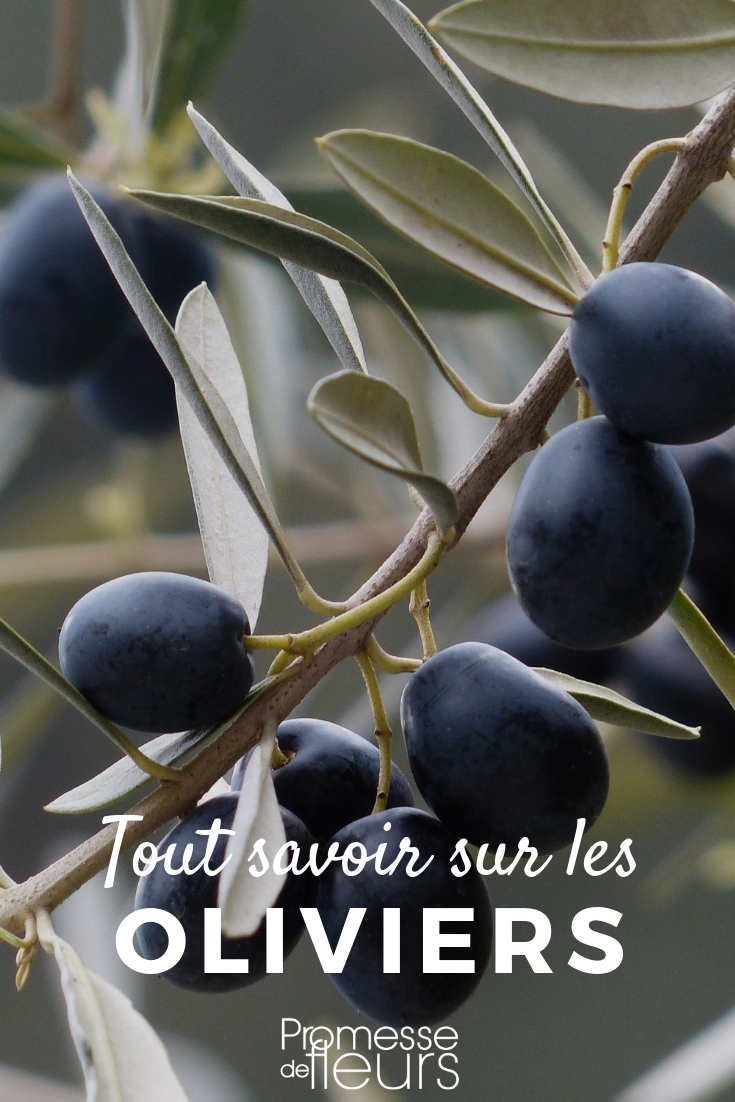
































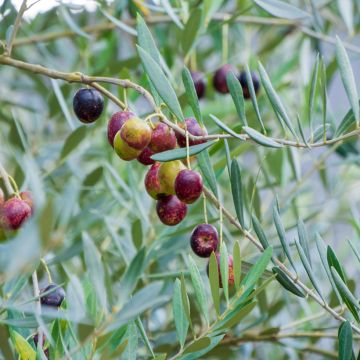


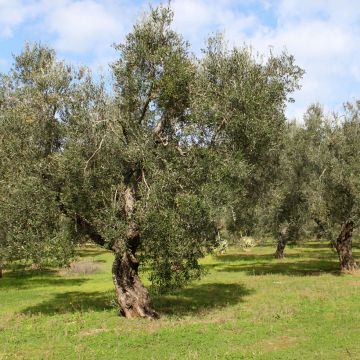


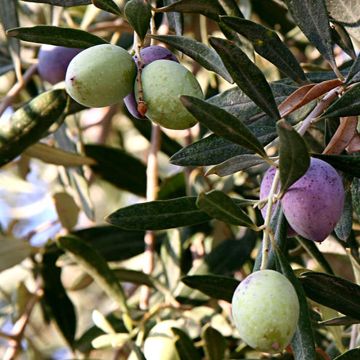
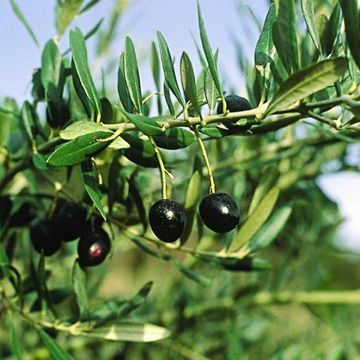
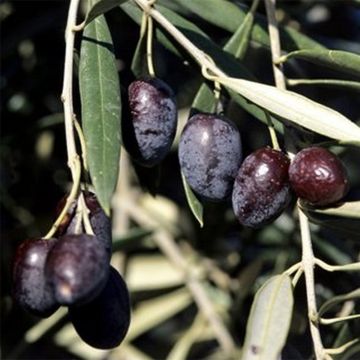
Feedbacks